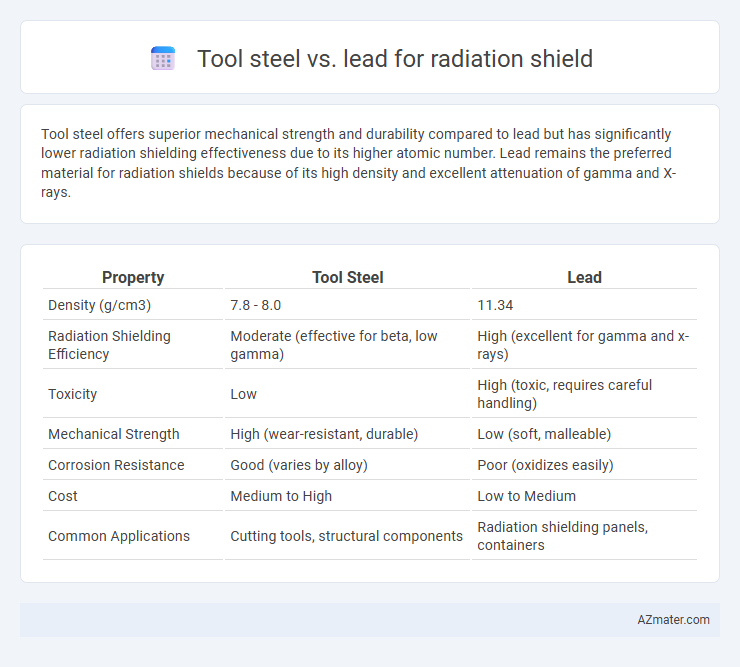Tool steel offers superior mechanical strength and durability compared to lead but has significantly lower radiation shielding effectiveness due to its higher atomic number. Lead remains the preferred material for radiation shields because of its high density and excellent attenuation of gamma and X-rays.
Table of Comparison
| Property | Tool Steel | Lead |
|---|---|---|
| Density (g/cm3) | 7.8 - 8.0 | 11.34 |
| Radiation Shielding Efficiency | Moderate (effective for beta, low gamma) | High (excellent for gamma and x-rays) |
| Toxicity | Low | High (toxic, requires careful handling) |
| Mechanical Strength | High (wear-resistant, durable) | Low (soft, malleable) |
| Corrosion Resistance | Good (varies by alloy) | Poor (oxidizes easily) |
| Cost | Medium to High | Low to Medium |
| Common Applications | Cutting tools, structural components | Radiation shielding panels, containers |
Introduction to Radiation Shielding Materials
Radiation shielding materials like tool steel and lead serve distinct purposes based on their density and atomic number; lead offers superior attenuation of gamma rays due to its high atomic number (82), while tool steel provides structural strength and moderate radiation protection. Tool steel's combination of iron, carbon, and alloying elements results in durable shields suitable for environments requiring mechanical resistance alongside radiation attenuation. Selection between tool steel and lead depends on application-specific factors such as radiation type, energy levels, physical strength requirements, and environmental considerations.
Overview of Tool Steel Properties
Tool steel offers high tensile strength, excellent hardness, and superior wear resistance, making it suitable for demanding industrial applications. Its dense microstructure provides effective attenuation of radiation, although not as dense as lead, which is commonly used for radiation shielding due to its high atomic number and density. Tool steel's thermal stability and mechanical durability enable it to withstand harsh environments, offering an alternative when lead's toxicity and softness present limitations.
Overview of Lead Properties
Lead exhibits exceptional radiation shielding properties due to its high atomic number (Z=82) and density (11.34 g/cm3), effectively attenuating gamma rays and X-rays. Its malleability allows easy shaping and installation in various protective applications. Despite its toxicity, lead remains a preferred material in radiation shielding compared to tool steel, which has lower density and atomic number, resulting in less efficient radiation absorption.
Radiation Attenuation Capabilities: Tool Steel vs. Lead
Tool steel demonstrates significantly lower radiation attenuation capabilities compared to lead due to its lower atomic number and density, making it less effective at absorbing gamma rays and X-rays. Lead's high density (11.34 g/cm3) and atomic number (82) provide superior shielding by effectively attenuating a broader spectrum of ionizing radiation. While tool steel offers mechanical strength and durability, lead remains the preferred material for radiation shields requiring maximum attenuation efficiency.
Mechanical Strength and Durability Comparison
Tool steel exhibits significantly higher mechanical strength and durability compared to lead, making it more resistant to deformation and wear under mechanical stress. While lead offers excellent radiation shielding due to its high density, its relatively low hardness and poor tensile strength limit its structural applications. Tool steel's alloy composition provides enhanced performance in demanding environments, ensuring longer service life when used in radiation shield supports or housings.
Environmental and Health Considerations
Tool steel offers a more environmentally friendly alternative to lead for radiation shielding due to its lower toxicity and recyclability, reducing hazardous waste risks. Lead, while effective in radiation attenuation, poses significant health hazards including lead poisoning and environmental contamination from improper disposal. Choosing tool steel minimizes ecological impact and long-term health risks associated with lead exposure in shielding applications.
Cost Analysis: Tool Steel vs. Lead
Tool steel offers higher durability and structural strength for radiation shielding but comes at a significantly higher initial cost compared to lead. Lead remains the most cost-effective material due to its dense atomic structure and lower market price per unit weight, making it preferable for budget-sensitive projects. Maintenance and replacement expenses can increase total costs for lead over time, while tool steel's longevity may reduce lifecycle spending despite its upfront investment.
Applications in Medical and Industrial Settings
Tool steel offers superior structural strength and durability compared to lead, making it ideal for radiation shields in medical and industrial equipment that require frequent handling or mechanical stress. Lead's high density and excellent radiation attenuation properties are preferred in protective barriers and garments for X-ray rooms and radiology labs where flexible, lightweight shielding is essential. Combining tool steel with lead inserts often enhances both mechanical protection and radiation shielding efficiency in advanced medical devices and industrial radiography setups.
Installation and Handling Requirements
Tool steel requires specialized welding and machining processes during installation due to its hardness and density, ensuring a precise fit for radiation shielding applications. It is heavier and more rigid, demanding robust support structures and protective equipment for safe handling. Lead, being softer and more malleable, allows easier cutting and shaping on-site but necessitates careful handling and disposal protocols to prevent toxic exposure during installation.
Future Trends in Radiation Shielding Materials
Tool steel offers superior mechanical strength and durability compared to lead in radiation shielding, making it suitable for applications requiring structural integrity under high stress. Emerging materials combine the high-density advantage of lead with non-toxic, eco-friendly properties, pushing the development of composite shielding solutions. Future trends emphasize lightweight, high-performance alloys and nanomaterials that enhance radiation attenuation while reducing environmental and health hazards.

Infographic: Tool steel vs Lead for Radiation shield
 azmater.com
azmater.com